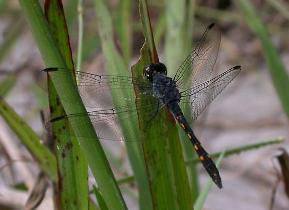The seaside dragonlet is the only true salt-water dragonfly in North America. These dragonflies often perch facing into the wind, presumably to help provide lift on take-off.
Photo Credit: Jeff Hollenbeck
Erythrodiplax berenice
Common Name: seaside dragonlet
Animal Guild: Insect
Class > Order > Family: Insecta > Odonata > Libellulidae
What does the species look like?
Both sexes: Both sexes have black legs and often hold their wings cocked downward. Juveniles of both sexes are mostly black with narrow, yellow stripes on the thorax and tail, and brown spots at the base of the wings.
Males: Mature males are small and slender, and all black with no wing spots. The male thorax is dark navy blue to black and gets darker toward the abdomen. The abdomen is slender and black with dull orange spots that fade with age. The wings are clear and unmarked. The eyes are dark brown, and the face is blackish.
Females: The typical thorax of the female and immature male is intricately patterned in narrow orange and black "tiger" stripes with black on the front and sides. The abdomen is mostly orange above and black below. The face is pale with broad black stripes that become nearly dark blue with age. The wings of some females have a large amber patch at the mid-point and amber at the base while others do not have any wing markings. As females age, they become darker and similar to males in coloring. Females are variable during this transition time; the thorax turns black before the abdomen, and some females may have an amber spot on each wing.
Total length: 11 to 13.8 inches (28 to 35 mm); abdomen: 5.9 to 9 inches (15-23 mm); hindwing: 7.1 to 10.2 inches (18-26 mm)
Similar species: No similar-looking species are found in salt-water habitats.
Where is the species found?
States & Provinces
AL, CT, DE, FL, GA, LA, MA, MD, ME, MS, NC, NJ, NM, NS, NY, PA, QC, RI, SC, TX, VA
Distribution
This species is found along the eastern shores of the United States, and in saline lakes in the southwestern United States. It also occurs in the West Indies and Central America south to Venezuela and Trinidad.
The seaside dragonlet occurs in salt marshes and mangrove swamps in the eastern United States, and in saline lakes and sinkholes in the southwestern United States. These dragonflys often spend large amounts of time perched on stems and occasionally, flat on the ground. Pairs lay eggs in tandem in algal mats on the surface of salt water, often in large congregations.
General Phenology and Life History
This species occurs year around in the southern limits of its range. In areas like Texas and Louisiana, adults are active from January to November. In more northerly areas like New Hampshire and Massachusetts, adults can be seen from May to September.
Which phenophases should I observe?
Do you see/hear...?
Activity
Adults More...
For abundance, enter the number of individual animals observed in this phenophase.
Adults feeding Erythrodiplax berenice , adults feed on almost any flying insect they can catch.
For abundance, enter the number of individual animals observed in this phenophase.
Migrating adults More...
For abundance, enter the number of individual animals observed in this phenophase.
Reproduction
Mating For abundance, enter the number of individual animals observed in this phenophase.
Egg laying Erythrodiplax berenice , females often lay eggs while still being grasped by their mate.
For abundance, enter the number of individual animals observed in this phenophase.
Development
Recently emerged adults For abundance, enter the number of individual animals observed in this phenophase.
Dead adults For abundance, enter the number of individual animals observed in this phenophase.
Method
Individuals at a light For abundance, enter the number of individual animals observed in this phenophase.
Individuals in a net For abundance, enter the number of individual animals observed in this phenophase.
Individuals in a trap For abundance, enter the number of individual animals observed in this phenophase.
What do these phenophases look like?
There is currently no photoguide available for this species. If you'd like help us create one, use the guidance document and species template provided here . Then send it via email to education@usanpn.org when it is complete.
